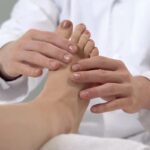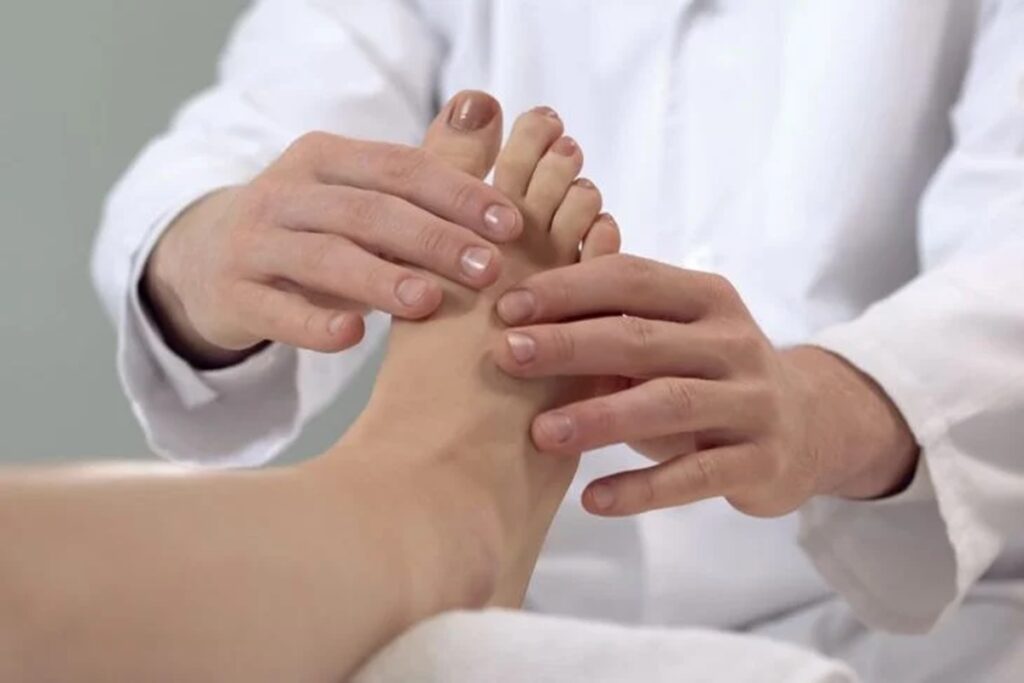Sharp pain in the arch of foot can be debilitating, significantly affecting your ability to perform daily activities. Whether the pain arises during physical activity or persists even when resting, identifying the cause and receiving appropriate treatment is crucial. Conditions like plantar fasciitis, tendinitis, and stress fractures can all contribute to this discomfort, but the …
Sharp pain in the arch of foot can be debilitating, significantly affecting your ability to perform daily activities. Whether the pain arises during physical activity or persists even when resting, identifying the cause and receiving appropriate treatment is crucial. Conditions like plantar fasciitis, tendinitis, and stress fractures can all contribute to this discomfort, but the right intervention can provide relief. Understanding the underlying causes of sharp pain in arch of foot will guide you towards effective treatment options, including Plantar Fasciitis Treatment, and help you get back on your feet faster.
With this guide, you’ll learn the causes, symptoms, treatment options, and when to seek help from a foot and ankle doctor. Managing this pain starts with understanding its root causes and seeking the right care from a foot and ankle doctor near me.
Understanding Sharp Arch Pain
Sharp pain in arch of foot is often caused by underlying structural issues or injury. The foot arch is responsible for distributing weight and providing balance, so pain in this area can interfere with basic movement and comfort. By understanding the anatomy of the foot and what causes the pain, you can better identify potential treatment options.
Anatomy of the Foot Arch and Common Pain Triggers
The arch of the foot includes several structures that support your body weight while walking and standing. These include the plantar fascia, posterior tibial tendon, and several smaller muscles and ligaments. Conditions like adult-acquired flatfoot, flat feet, or high arches can lead to excess strain and discomfort in the arch. Improper footwear, overpronation, and poor biomechanics can also cause irritation and trigger sharp pain in arch of foot.
Why Sharp Pain Occurs in the Arch
Sharp pain in arch of foot often occurs because of inflammation or strain on the tissues in the arch. When the plantar fascia becomes overstretched or inflamed, it leads to pain in the heel or arch. Tight calf muscles or poor foot alignment can further exacerbate this condition. As the foot’s arch bears the weight of the body during movement, any disruption in this balance leads to discomfort and pain.
Causes of Sharp Pain in Arch of Foot
Understanding the various sharp pain in arch of foot causes is crucial for getting the right treatment. Below are some common reasons for sharp pain in arch of foot that require professional diagnosis.
Plantar fasciitis is a common cause of sharp pain in arch of foot. This condition occurs when the plantar fascia, the thick band of tissue running across the bottom of the foot, becomes irritated and inflamed. Plantar fasciitis typically causes pain at the heel, but it can also affect the arch. Plantar fasciitis is a common and often frustrating condition that results from ongoing irritation and degeneration of the plantar fascia, particularly at its attachment point on the medial calcaneal tuberosity of the heel, along with the surrounding tissue structures. The pain from plantar fasciitis is often worse in the morning or after periods of rest when the fascia is tight and stretched with the first steps.
Plantar Fasciitis and Fascia Tears
Plantar fasciitis, the inflammation of the plantar fascia, is the most common cause of sharp pain in arch of foot. This condition occurs when the thick band of tissue in the foot becomes overstretched or torn, causing sharp pain in the arch. The pain is often most severe with the first steps in the morning or after prolonged periods of rest. Plantar Fasciitis Treatment includes rest, ice, NSAIDs, and custom orthotics to provide support and relieve tension.
Tendonitis (Posterior Tibialis, Peroneal)
Tendonitis in the posterior tibialis tendon or peroneal tendons can lead to pain in the foot’s arch. The pain is often accompanied by swelling and tenderness along the tendon. Overuse or biomechanical issues such as flat feet can contribute to posterior tibial tendon dysfunction, which places additional strain on the arch and causes pain. Proper tendonitis treatment involves physical therapy, rest, and anti-inflammatory medications.
Stress Fractures or Bone Spurs
Stress fractures in the bones of the foot or bone spurs that develop due to wear and tear from activities like running can also lead to sharp pain in arch of foot. These fractures or spurs place pressure on surrounding tissues, leading to inflammation and pain. Imaging tests like X-rays or MRI scans are necessary to diagnose fractures, while shockwave therapy and cortisone injections can help treat bone spurs.
Nerve Compression and Other Conditions
Nerve compression, such as in tarsal tunnel syndrome, can also cause sharp pain in arch of foot. The pain may be sharp or burning, and numbness may also occur. Peripheral neuropathy, often caused by diabetes, can result in pain in the foot and toes. Treating nerve compression involves physical therapy, custom orthotics, and possibly surgical intervention in more severe cases.
Sharp Arch Pain When Resting

Some individuals experience sharp pain in arch of foot when resting, which can make daily activities more difficult. Understanding why the pain persists during rest and how it differs from pain caused by activity is essential for determining the best course of action.
Why Pain Persists Despite Rest
If sharp pain in arch of foot when resting persists, it may indicate that the inflammation or injury is significant enough to affect the arch even when at rest. Plantar fasciitis and tendonitis can cause ongoing discomfort that doesn’t subside with rest alone. In some cases, structural imbalances, like flat feet, may cause chronic pressure on the arch, even when you’re not actively walking or standing.
Distinguishing Rest Pain from Activity Pain
Sharp pain in arch of foot when resting often feels like a deep, constant ache, whereas pain from activity tends to be more intense and localized. Rest pain is typically more consistent and might feel worse when pressure is applied, such as when standing or walking after sitting for a while. Identifying this difference can help your foot and ankle doctor pinpoint the underlying issue.
When Rest Indicates Serious Underlying Issue
If sharp pain in arch of foot when resting is accompanied by significant swelling, bruising, or the inability to bear weight, it could indicate a more serious condition, such as a stress fracture or tendon tear. Immediate professional evaluation is recommended to rule out more severe problems.
Diagnosis and Evaluation
To treat sharp pain in arch of foot effectively, a proper diagnosis is crucial. Your foot and ankle doctor will conduct a detailed evaluation and order the appropriate tests to determine the exact cause.
Clinical Foot Examination and Patient History
A foot and ankle doctor will begin by taking a detailed patient history to understand the symptoms and any activities that may have contributed to the pain. A physical exam will be performed to check the foot’s alignment, range of motion, and areas of tenderness. Understanding the biomechanics of the foot can help the doctor identify issues like overpronation or flat feet that may be contributing to the pain.
Imaging – X-ray, Ultrasound, MRI
Imaging tests such as X-rays, MRI scans, and ultrasound can help diagnose conditions like plantar fasciitis, bone spurs, or stress fractures. These tests provide detailed insights into the bone and soft tissue structures in the foot, helping to identify the exact cause of the pain.
Tests Used to Identify the Specific Cause
To accurately diagnose sharp pain in arch of foot, additional tests like biomechanical assessments or nerve conduction studies may be used to evaluate nerve function and muscle imbalances. These tests are crucial for conditions like tarsal tunnel syndrome or posterior tibial tendon dysfunction.
Sharp Arch Pain Treatment Options
Pain along the bottom of the foot, from the heel to the ball of the foot, is often referred to as arch pain. This type of discomfort can be caused by a variety of factors, including structural imbalances, tendon inflammation, or injury. Sharp pain in arch of foot can be debilitating and typically occurs with activities like walking, standing, or running. The pain may radiate throughout the arch and may be linked to conditions like plantar fasciitis, tendonitis, or stress fractures. Understanding the root cause is essential for selecting the best treatment plan to alleviate discomfort and improve function.
Here are various treatment options for managing sharp pain in arch of foot, ranging from home care to professional intervention. Early treatment can alleviate pain and prevent further damage.
Immediate Care (Rest, Ice, Orthotics)
For immediate relief from sharp pain in arch of foot, the R.I.C.E. method (Rest, Ice, Compression, Elevation) is often recommended. Ice helps reduce inflammation, while custom orthotics provide support to alleviate pressure on the arch. Proper footwear with arch support can also be helpful in managing pain and preventing further irritation.
Physical Therapy and Stretching Exercises
Physical therapy is crucial for restoring foot function and flexibility. Stretching exercises for the plantar fascia and Achilles tendon help reduce tension in the arch and improve mobility. A therapist may also recommend strengthening exercises to improve support around the foot and reduce pain.
Medication, Injections, Shockwave Therapy
For more persistent pain, anti-inflammatory medications such as NSAIDs may be used to control swelling. Cortisone injections can provide targeted relief for inflammation, while shockwave therapy may help stimulate healing in conditions like plantar fasciitis.
Surgical Options for Severe Arch Conditions
In rare cases, when conservative treatments fail, surgery may be necessary. Surgical options include fascial release for plantar fasciitis, or tendon repair procedures for conditions like posterior tibial tendon dysfunction.
Sharp Arch Pain Recovery and Prevention
Once the pain has been addressed, it’s important to follow a recovery plan to ensure healing and prevent recurrence.
Timeline for Healing and Activity Resumption
The healing timeline for sharp pain in arch of foot depends on the underlying cause. For conditions like plantar fasciitis, it may take several weeks to months for the pain to subside. It’s important to follow the doctor’s advice for gradually resuming physical activity to avoid re-injury.
Shoe Selection and Orthotic Recommendations
Wearing supportive shoes with a wide toe box and proper arch support is essential for recovery. Custom orthotics can be used to correct biomechanical issues and provide extra support during the healing process.
Lifestyle Adjustments to Avoid Recurrence
To prevent sharp pain in arch of foot from returning, lifestyle changes such as weight management, avoiding high-impact activities, and incorporating regular stretching exercises can be beneficial. Maintaining a healthy weight will reduce stress on the arch, while low-impact activities like swimming or cycling will help keep you active without exacerbating the pain.
Why Choose Wisconsin Foot & Ankle Clinic

At Wisconsin Foot & Ankle Clinic, we specialize in diagnosing and treating sharp pain in arch of foot with personalized care plans tailored to your needs.
Expert Board-Certified Foot & Ankle Physicians
Our team of board-certified foot and ankle physicians has the expertise to accurately diagnose and treat a wide range of foot conditions, including sharp pain in arch of foot. We provide comprehensive care, from conservative treatments to advanced surgical interventions.
Personalized Care Plans for Sharp Arch Pain
We offer personalized care plans that are designed to address your unique condition. Whether you need custom orthotics, physical therapy, or Plantar Fasciitis Treatment, we are committed to providing effective solutions for your arch pain.
Local Wisconsin Locations and Convenient Booking
With convenient locations across Wisconsin, we make it easy to schedule an appointment and receive the care you need. Foot and ankle doctor near me services are available for your convenience, ensuring timely and effective treatment.
Conclusion
If you’re experiencing sharp pain in arch of foot, don’t wait to seek help. Early intervention and treatment can prevent further damage and ensure a smoother recovery process. With the right care, including Plantar Fasciitis Treatment, Conservative Therapy, and professional guidance, you can reduce pain and get back to your active lifestyle.
FAQs
Is Sharp Arch Pain Normal?
While sharp pain in arch of foot is common, it should not be ignored, especially if it persists. It’s important to consult a foot and ankle doctor for proper diagnosis and treatment.
Can It Heal Without Seeing a Doctor?
In some cases, sharp pain in arch of foot may improve with rest and self-care. However, if pain persists or worsens, it’s best to seek professional care.
When Should I Worry and Seek Care?
If your sharp pain in arch of foot is accompanied by swelling, redness, or difficulty walking, it’s time to see a foot and ankle doctor to rule out serious conditions like fractures or tendon tears.







